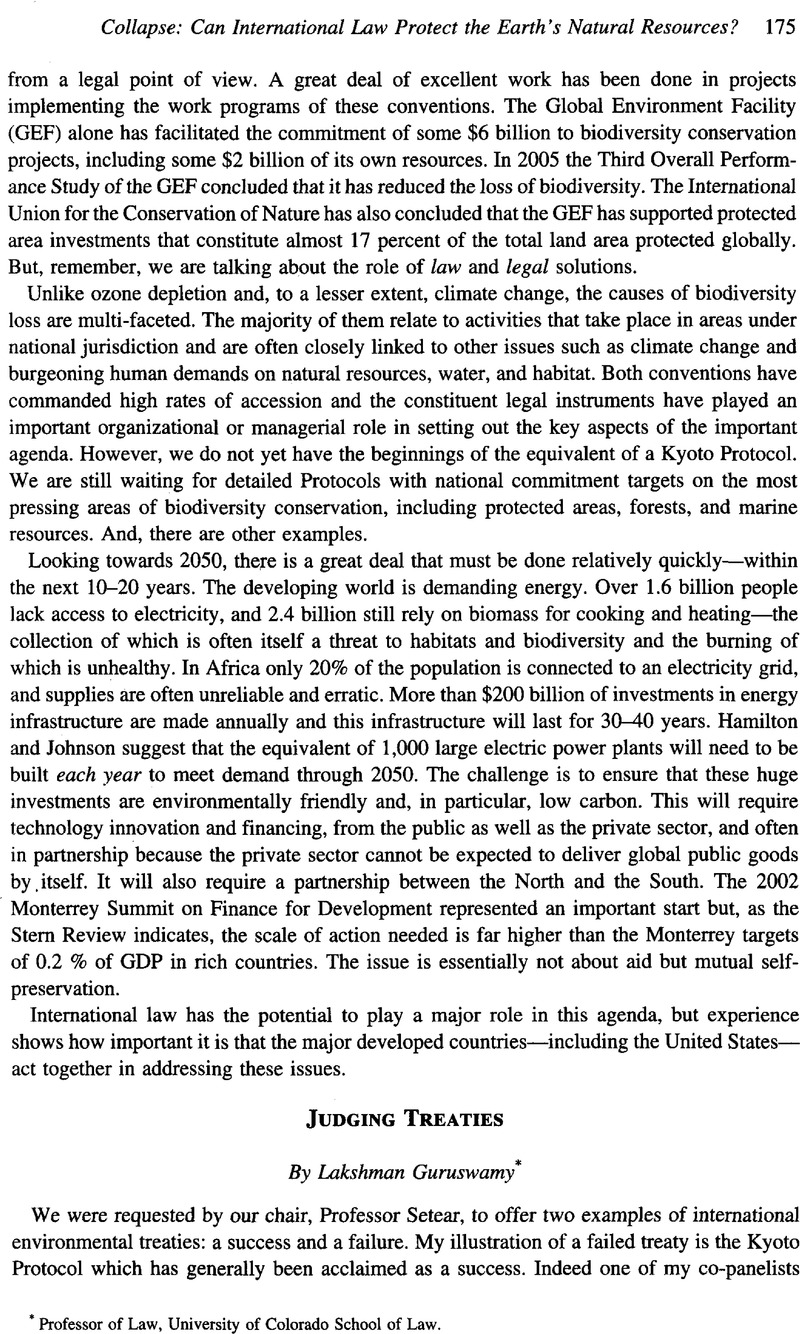No CrossRef data available.
Article contents
Judging Treaties
Published online by Cambridge University Press: 28 February 2017
Abstract

- Type
- Collapse: Can International Law Protect the Earth’s Natural Resources?
- Information
- Copyright
- Copyright © American Society of International Law 2007
References
1 See Alvarez, Jose E. Why Nations Behave, 19 Mich. J. Int’l L. 303, 305 (1998)Google Scholar.
2 See Dinah Shelton, Commitment and Compliance (2000); Edith Brown Weiss & Harold Jacobson, Engaging Countries: Strengthening Compliance With Environmental Accords (1998).
3 See Fitzmaurice, M. A. & Redgwell, C., Environmental Non-Compliance Procedures and International Law, 31 Neth. Y. B. Int’l L. 35 (2000)CrossRefGoogle Scholar.
4 See Downs, George W. et al., Is the Good News About Compliance Good News About Cooperation?, 50 Int’L Org. 379, 383 (1996)CrossRefGoogle Scholar.
5 Raustiala, Kal, Compliance & Effectiveness in International Regulatory Cooperation, 32 Case W. Res. J. Int’l L. 387, 393-94 (2000)Google Scholar. Although Raustiala conflates the two concepts, this article draws a distinction between effectiveness and impact. It is possible that while a treaty might have a negligible impact on the underlying problem, it is nonetheless part of a broader response to the problem that, when considered in its entirety, exerts a far more meaningful impact. to the extent this is the case, the treaty should, in the evaluative rubric set forth here, be self-identified as part of this larger and ostensibly coordinated response.
6 Abram Chayes & Antonia Handler Chayes, The New Sovereignty (1995); Thomas M. Franck, Fairness in International Law and Institutions (1995); Downs et al., supra note 4; Koh, Harold Hongju, Why Do Nations Obey International Law?, 106 Yale L. J. 2599, 2603 (1997)CrossRefGoogle Scholar; Young, Oran R. et al., Regime Effectiveness: Taking Stock in The Effectiveness of International Environmental Regimes 249 (Young, Oran R. ed., 1999)Google ScholarPubMed.
7 The Implementation and Effectiveness of International Environmental Commitments: Theory and Practice, at IX (David G. Victor et al. eds., 1998).
8 See Weiss & Jacobson, supra note 2 and accompanying text.
9 EIA, International Energy Outlook 2006, Highlights 1-2 (2006), available at <http://www.eia.doe.gv/oiaf/ieo/index.html>.
10 Kyoto Protocol, Art. 2(l)(a)(I). This included references to research, development, and increased use of new and renewable forms of energy, carbon dioxide sequestration technologies, and advanced and innovative environmentally sound technologies. Art. 2(l)(a)(iv).
11 Id., Arts. 4-11.
12 EIA, supra note 9, at 2.
13 EIA, Long Term World Oil Supply, available at <http://www.eia.doe.gov/pub/oil_gas/petroleum/presentations/2000/long_term_supply/sld001.htm>. EIA used these findings to develop 12 scenarios for peak oil. They were based on the three USGS predictions of oil reserves (high, expected, and low), and four growth rates (0%, 1%, 2%, and 3%).
14 Hirsch, Robert L. Et Al., Peaking of World Oil Production: Impact, Mitigation and Risk Management 69 (2005)Google Scholar.
15 Cambridge Energy Research Associate, Press Release, Peak Oil Theory—”World Running Out of Oil Soon”— Is Faulty; Could Distort Policy & Energy Debate (2006).
16 Hirsch Et Al., supra note 14, at 69.
17 7 EIA, supra note 13, at 1-2.
18 Id.
19 United Nations Framework Convention on Climate Change, May 9, 1992, 1771 UNTS 165.
20 Art. 3(4).
21 Art. 4(c).
22 Arts. 3(3), 4(l)(b).
23 3 Art. 4(l)(c).
24 UNICEF, The State of the World’s Children (2000), available at <http://www.unicef.org/sowc00/>.
25 Mark Clayton, New Coal Plants Bury “Kyoto,” Christian Sci. Monitor, Dec 23, 2004, at 1.
26 Richard Ingham, EU Way off Course for Meeting Kyoto Targets Say Latest Figures, June 22, 2006, available at <http://www.terradaily>.
27 Jones, Russell, An Assessment of the Kyoto Protocol, 11 Geo. Int’l Envtl. L. Rev. 767, 777 (1999)Google Scholar.
28 Jacoby, Henry D. et al., Kyoto’s Unfinished Business, 77 Foreign Aff. 63, 64 (July/Aug. 1998)CrossRefGoogle Scholar.
29 Wigley, Tom, The Kyoto Protocol: CO2, CH4 and Climate Implications, 25 Geophysical Res. Letters 2285 (1998)CrossRefGoogle Scholar. If, on the other hand, after the Protocol expires, the Annex B countries continued to abide by Kyoto’s limits but did not make any new commitments further to cut emissions for the rest of the century, the results were not dramatically different. This “constant compliance” scenario would shave 0.11 to 0.21 degrees Celsius (0.20 to 0.38°F) off global average temperatures by 2100. Stated another way, instead of heating up by 2.5°C (4.5°F), a midpoint in the range of projections of global warming, Earth would warm approximately 6% less.


